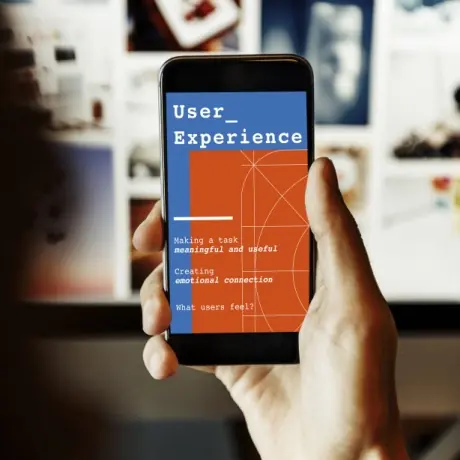In today’s fast-paced digital landscape, following the best practices in user experience design is crucial. User expectations are higher, and businesses need to keep up. But what is user experience design, exactly? It’s all about creating smooth, intuitive experiences for users across digital platforms. From web design and development to mobile interfaces, a strong UX design strategy ensures that people can easily navigate your products. When you follow the best practices in user experience design, you not only meet user expectations but also maintain design consistency. That’s the key to keeping users happy and returning for more.
By implementing such practices, businesses can see real results, like higher engagement and improved customer satisfaction. When done right, UX design can lead to significant business growth. Whether it’s creating seamless navigation or ensuring a visually appealing layout, good UX can make or break your digital product. In this article, we’ll dive into what UX design is, its benefits, and eight of the best practices that will elevate both your user experience and your business.

What is User Experience Design?
User Experience (UX) design is all about making sure that users have meaningful and engaging interactions with digital products, like websites and apps. It focuses on what users need and expect, so their experience is smooth and easy to follow. UX design doesn’t just look at how things appear. It also covers usability, how well things work, and accessibility for everyone. A strong UX design strategy helps UX designers create products that allow a positive user experience. In doing so, users can navigate easily, complete tasks quickly, and feel satisfied with the products. By following best practices in user experience design, businesses can improve the user’s experience and increase customer loyalty and engagement.
Key Components of User Experience Design
To create an optimal user experience, designers focus on several key components. By addressing each of these, businesses can deliver products that not only meet functional requirements but also foster user satisfaction.
Usability
This ensures the product is easy to navigate and intuitive to use. Users should be able to accomplish tasks without confusion or difficulty, enhancing the overall user journey.
Accessibility
UX design must cater to all users, including those with disabilities. This includes providing screen reader support and designing interfaces that accommodate various needs, ensuring equal access for everyone.
Aesthetics
A visually pleasing interface enhances user engagement. Aligning the design with the brand identity and ensuring clean, consistent visuals across platforms contributes to a positive emotional response.
User Research
Understanding user behaviors, preferences, and pain points is essential for creating products that resonate with users. Research methods include interviews, surveys, and usability testing.
Information Architecture
Organizing and structuring information in a way that makes it easy for users to find what they need is crucial. This involves designing clear navigation paths and logical content flow.
Prototyping and Wireframing
Before full development, designers create wireframes and prototypes to test ideas and identify potential issues early on. This step is vital in ensuring a smooth UX design process.
Interaction Design
Defining how users interact with the product, including responsiveness and system feedback, ensures that the product feels natural and efficient to use.
Performance Optimization
A key part of responsive web design is optimizing the speed and performance of digital products. This ensures smooth user experiences across different devices and platforms.

The Benefits of Good User Experience Design
A well-executed User Experience (UX) design significantly improves customer engagement and satisfaction. It ensures that users enjoy a smooth, intuitive journey while interacting with a product, whether it’s a website or app. By focusing on how users feel and interact, businesses can elevate their digital experiences and build lasting connections with their customers. Following best practices in user experience design not only enhances the user’s journey but also directly impacts business success through increased loyalty and conversions.
Increased Conversions
A user-friendly design makes it easy for customers to find what they need and complete their purchases quickly. By removing obstacles and simplifying processes, good UX increases conversions, leading to revenue growth and business success.
Improved Customer Loyalty
Satisfied customers are more likely to return and recommend a product or service. Good UX design fosters positive interactions, building trust and loyalty. This results in more repeat business and higher customer retention.
Reduced Bounce Rates
When users struggle to navigate a site, they leave. By creating an intuitive and user-friendly design, businesses can keep users engaged longer, reducing bounce rates and increasing engagement.
Better User Satisfaction
A seamless design aligned with user expectations leads to higher user satisfaction. Satisfied users are more likely to leave positive reviews, further enhancing a brand’s reputation.
Enhanced Customer Journey
Good UX design ensures a smooth and enjoyable customer journey. It eliminates friction points, helping users move through the site or app effortlessly.
By following best practices in user experience design, businesses can create digital products that are intuitive, user-friendly, and meet user expectations. This leads to higher conversions, better customer loyalty, and a smoother customer journey. Reduced bounce rates and increased satisfaction strengthen customer relationships, driving long-term growth. Great UX design meets user needs and transforms how businesses engage with and keep customers. This ensures ongoing business success.

8 Best Practices in User Experience Design for Consistency
Effective User Experience (UX) design is key to creating digital products that are both functional and enjoyable. By focusing on users’ needs, businesses can enhance customer satisfaction, engagement, and loyalty. Following best practices in user experience design ensures that products meet user expectations, improve usability, and contribute to long-term business growth. Each step in the UX design process, from user research to visual hierarchy, plays a crucial role in optimizing the user experience.
1. Start with User Research and Analysis
Understanding user needs, pain points, and preferences is crucial in UX design. Conducting user research through methods like surveys, user personas, and usability testing, with help from a UX research agency, ensures that design decisions are grounded in real user data. This approach reduces guesswork and helps tailor products that truly meet user expectations.
2. Focus on Usability and Accessibility
A successful design must be intuitive and accessible to all users. Following usability testing and WCAG (Web Content Accessibility Guidelines) ensures that products are easy to navigate and inclusive for people with varying abilities. This broadens the product’s user base and improves user satisfaction.
3. Focus on Mobile-First and Responsive Design
With mobile usage dominating, mobile UX and responsive design are essential. Designing for mobile first ensures that users have a seamless experience across devices. Responsive design adapts layouts and elements to fit various screen sizes, enhancing user satisfaction.
4. Simplify Navigation and Information Architecture
A well-organized information architecture is key to ensuring that users can find what they need quickly and easily. To ensure clarity and ease of use in information architecture and navigation design, follow these techniques:
Breadcrumb Navigation
Breadcrumbs provide users with a trail to follow, showing them where they are in the site’s structure. This helps users easily navigate back to previous pages and enhances overall clarity.
Clear Menus
Menus should be simple and well-organized, using familiar terms. Keeping the menu structure shallow reduces confusion and helps users quickly find what they need.
Logical User Flow
Organize content in a logical sequence, guiding users naturally from one section to another. This reduces friction and improves their experience by making the navigation intuitive.
Consistent Labeling
Use consistent labels and terminology across the site. This ensures users understand where clicking a link will take them, improving confidence in navigating the site.
Visible Search Bar
A search bar should always be visible and easy to access, allowing users to find specific content quickly if they can’t locate it through the menus.
Call-to-Action Prominence
Place key CTAs (Call to Action) in strategic locations, such as above the fold or at the end of a user journey. This guides users toward important actions, improving conversion rates.
5. Incorporate Visual Hierarchy and Effective Design Layouts
A strong visual hierarchy guides users’ attention to important elements, such as CTAs. Balancing elements like whitespace, typography, and imagery ensures that design layouts are visually appealing and easy to follow.
6. Use Data-Driven Design and Continuous Testing
Collecting user data helps refine designs. Using A/B testing, heatmaps, and user feedback, designers can make informed decisions to improve the overall UX. This data-driven design approach ensures continuous improvement based on real user interactions.
7. Ensure Consistency Across All Touchpoints
Maintaining brand consistency across all platforms creates trust and recognition. A consistent multi-platform UX strengthens the brand image and enhances the user experience by providing a uniform design language.
8. Partner with a User Experience Design Agency for Optimized Results
Partnering with a professional UX design agency can greatly enhance your digital products. Outsourcing UX design allows businesses to access expert knowledge, streamline processes, and improve user experiences. Here are the key benefits of outsourcing to a UX design agency:
Expert Knowledge and Specialized Skills
A UX design agency brings specialized expertise that in-house teams may lack. Their professionals stay updated on the latest trends, like glassmorphism in UX design, and apply best practices to deliver high-quality designs.
Objective Perspective
An external agency offers a fresh, unbiased view of your product. This allows them to identify opportunities for improvement and suggest innovative solutions you might overlook due to internal biases.
Cost Efficiency
Outsourcing to a professional UX design team reduces the need for costly internal resources. Agencies deliver faster results while saving businesses money by avoiding errors and reducing the need for multiple iterations.
Access to the Latest Tools and Technology
UX agencies use the most advanced tools for data-driven design and user-centered design processes. This ensures that your product development is efficient and aligned with current industry standards.
Focus on Core Business Functions
By delegating design tasks to a specialized agency, businesses can focus on their core responsibilities. This optimizes workflow and ensures that teams work more efficiently on high-priority tasks.
Faster Time-to-Market
UX design agencies work efficiently to meet deadlines, speeding up the development process. They ensure that your product is market-ready faster while maintaining high design standards.
Following best practices in user experience design helps businesses not only meet user needs but also drive growth and long-term success.

Achieve Success with ScreenRoot: UX Design Agency
Following best practices in user experience design is key to making sure your digital products meet user expectations and support business success. For example, creating a good hotel website design. Using strategies like user research, mobile-first design, and data-driven improvements helps businesses improve customer satisfaction, lower bounce rates, and increase conversion rates. These practices not only enhance your product’s usability but also build stronger customer loyalty and improve brand recognition. Keeping a consistent design across all platforms ensures that users enjoy a smooth and intuitive experience.
At ScreenRoot, we’re known for our commitment to delivering top-tier UX solutions. Whether it’s conducting UI UX audits, usability testing, or designing for next-gen devices, we’ve got you covered. If you’re ready to elevate your UX, now is the time to take action. Check out our Work page here to see how we can help.
Need more information? Feel free to reach out via WhatsApp or call us at 1800 121 5955 (India), or send an email to [email protected]. You can also connect with us through our Contact Form to explore how partnering with a professional UX design agency can lead to sustainable, long-term success for your business. Let’s transform your digital experience together!







